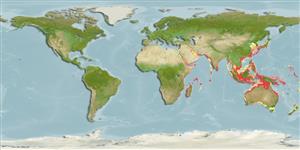Environment: milieu / climate zone / depth range / distribution range
Écologie
marin démersal; profondeur 14 - 60 m (Ref. 30573), usually 15 - 50 m (Ref. 4313). Deep-water
Indo-West Pacific: Red Sea and the Persian Gulf south to Natal, South Africa and east to India and the Philippines, north to China and Japan, south Australia.
Taille / Poids / Âge
Maturity: Lm ? range ? - ? cm
Max length : 20.0 cm TL mâle / non sexé; (Ref. 48635); common length : 10.0 cm TL mâle / non sexé; (Ref. 3503)
Épines dorsales (Total): 14 - 16; Rayons mous dorsaux (Total): 8-10; Épines anales 3-4; Rayons mous anaux: 6 - 8. Bluish grey in color, belly pale; large black spot on rear half of spinous dorsal (Ref. 4313).
Inhabits soft bottoms of the continental shelf. Primarily known from trawls over prawn-grounds but divers looking in suitable habitats can come across them, especially at night. During the day it buries itself deep in the sand with just the eyes exposed. When disturbed, it spreads its long pectoral fins with the bright upper color to deter predators. It uses its fins to corner prey and has sensitive barbels below the mouth to detect those buried in the substrate (Ref. 48635). Fin spines venomous (anterolateral glandular groove with venom gland (Ref. 57406)) (Ref. 30573). Sold in small quantities either fresh or dried and salted in markets. Minimum depth reported taken from Ref. 57178.
Life cycle and mating behavior
Maturité | Reproduction | Frai | Œufs | Fécondité | Larves
Poss, S.G. and K.V. Rama Rao, 1984. Scorpaenidae. In W. Fischer and G. Bianchi (eds.) FAO species identification sheets for fishery purposes. Western Indian Ocean (Fishing Area 51). Vol. 4. FAO, Rome. pag. var. (Ref. 3503)
Statut dans la liste rouge de l'IUCN (Ref. 130435)
Utilisations par l'homme
Pêcheries: intérêt commercial mineur
Plus d'informations
Noms communsSynonymesMétabolismePrédateursÉcotoxicologieReproductionMaturitéFraiRassemblement de ponteFéconditéŒufsDéveloppement de l'œuf
RéférencesAquacultureProfil d'aquacultureSouchesGénétiqueElectrophoresesHéritabilitéPathologiesTraitementNutrientsMass conversion
CollaborateursImagesStamps, Coins Misc.SonsCiguateraVitesseType de nageSurface branchialeOtolithesCerveauxVision
Outils
Articles particuliers
Télécharger en XML
Sources Internet
Estimates based on models
Preferred temperature (Ref.
123201): 23.3 - 29, mean 28 °C (based on 1680 cells).
Phylogenetic diversity index (Ref.
82804): PD
50 = 1.1250 [Uniqueness, from 0.5 = low to 2.0 = high].
Bayesian length-weight: a=0.01175 (0.00462 - 0.02990), b=3.02 (2.80 - 3.24), in cm total length, based on LWR estimates for this (Sub)family-body shape (Ref.
93245).
Niveau trophique (Ref.
69278): 3.6 ±0.5 se; based on size and trophs of closest relatives
Fishing Vulnerability (Ref.
59153): Low vulnerability (10 of 100).
